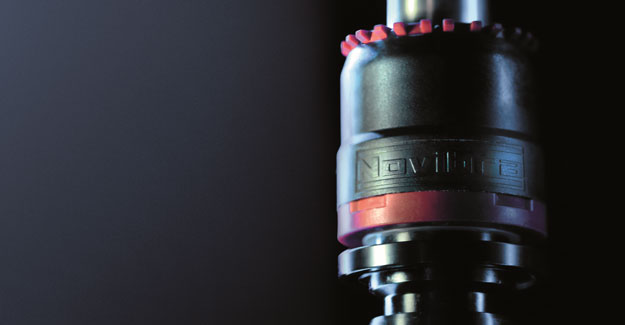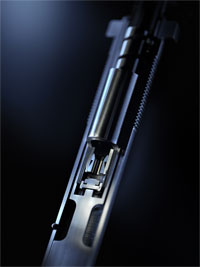
LENA and CROCOdoff – The Perfect Match For Efficient Spinning
Every spinning mill around the world faces the dual challenge of high energy consumption and a shortage of skilled labour. The only way to remain competitive is to automate and increase efficiency. This is where Novibra steps in with the low-energy and noise-absorbing spindle LENA and the underwinding-free clamping and cutting crown CROCOdoff.
Full reliability and long service life of spindles are decisive success factors for spinning mills. Modern spindles are expected to deliver faster speeds and greater productivity, no running-in time and, thanks to long lubrication cycles, less maintenance. The most important long-term goals are energy and cost savings. Furthermore, the falling number of available workers in today’s spinning mills calls for more automation. Machines are now being upgraded with auto-doffers and spindles with underwinding free crowns so that they can run on fewer operators and less maintenance.
Novibra fulfils the market needs with LENA
[caption id="attachment_22216" align="alignleft" width="200"] LENA spindle for lower energy consumption (Fig 1)[/caption]
Novibra confirms its market leadership and leverages its proven spindle technology to deliver on these urgent market needs with LENA, which stands for Low Energy and Noise Absorption (Fig.1).LENA is the latest addition to Novibra’s spindle family and combines the company’s signature spindle technology and design concepts with new features. Novibra’s spindle technology is characterized by a unique hydro dynamic two-level bearing system that effectively absorbs imbalances caused by belt tension, full cop imbalances, traveller tension and more. The absorption of imbalances is why the spindle can boastthe industry’s longest operational lifetime and high reliability.
Technical optimizations save energy and reduce noise
LENA was designed to attain the fastest speeds with low energy consumption, reaching up to 30,000 rpm while saving on average between 4% and 6% of energy. LENA’s second damping system is why it can reduce noise efficiently. This unique and well-proven noise absorbing system assembly, firmly established in Novibra NASA spindles, ensures both minimum neck bearing load and vibration with little noise even at high speeds.
The LENA neck bearing diameter was reduced to 5.8 mm and so consequently the wharve diameter was also reduced to only 17.5 mm. From a power transmission perspective and compared to spindles with a standard wharve diameter, a smaller diameter allows operating the machine at lower speed. The spindle itself maintains the same speed and thus the desired yarn count and twist.
The footstep bearing unit consists of a radial and an axial bearing. The former is designed as a hydrodynamic plain bearing with the internal diameter of 3 mm. Besides many other factors, it is the small diameter of the shaft’s tip that allows further energy savings, as the power consumption of the radial bearing is directly influenced by its own diameter. This correlation has been confirmed already by the low energy consumption of the HPS 68/3 spindles.These optimisations all add up to make significant energy savings.
CROCOdoff for efficient clamping and cutting of the yarn
Novibra’s latest generation of clamping and cutting crowns, CROCOdoff (Fig. 2), offers improved functionalities and an optimised design that meets all the requirements of modern spinning mills. CROCOdoff noticeably optimises spinning automation as it not only helps to reduce the required maintenance time and costs. It also allows running the ring spinning machines more efficiently and economically and thus contributes to a reduction of energy consumption.
CROCOdoff enables doffing without underwound yarn left on the running spindle. The machine no longer needs to be stopped to clean the yarn catching area of the spindle so that yarn production continues seamlessly. After doffing, the yarn end flies out of the system and no open yarn tails are able to consume expensive energy.
The secret lies in the efficient clamping of the yarn. The catching area of the crown has a meander for catching and cutting the yarn. It is clamped tightly and prevented from slipping out. Extensive tests conducted on different raw materials proved the reliability of the system. It has been confirmed in practice through the reduction of the after-doff ends down rate.
Customer benefits – lower ends down rates, reduced maintenance
[caption id="attachment_22217" align="alignleft" width="100"]
LENA spindle for lower energy consumption (Fig 1)[/caption]
Novibra confirms its market leadership and leverages its proven spindle technology to deliver on these urgent market needs with LENA, which stands for Low Energy and Noise Absorption (Fig.1).LENA is the latest addition to Novibra’s spindle family and combines the company’s signature spindle technology and design concepts with new features. Novibra’s spindle technology is characterized by a unique hydro dynamic two-level bearing system that effectively absorbs imbalances caused by belt tension, full cop imbalances, traveller tension and more. The absorption of imbalances is why the spindle can boastthe industry’s longest operational lifetime and high reliability.
Technical optimizations save energy and reduce noise
LENA was designed to attain the fastest speeds with low energy consumption, reaching up to 30,000 rpm while saving on average between 4% and 6% of energy. LENA’s second damping system is why it can reduce noise efficiently. This unique and well-proven noise absorbing system assembly, firmly established in Novibra NASA spindles, ensures both minimum neck bearing load and vibration with little noise even at high speeds.
The LENA neck bearing diameter was reduced to 5.8 mm and so consequently the wharve diameter was also reduced to only 17.5 mm. From a power transmission perspective and compared to spindles with a standard wharve diameter, a smaller diameter allows operating the machine at lower speed. The spindle itself maintains the same speed and thus the desired yarn count and twist.
The footstep bearing unit consists of a radial and an axial bearing. The former is designed as a hydrodynamic plain bearing with the internal diameter of 3 mm. Besides many other factors, it is the small diameter of the shaft’s tip that allows further energy savings, as the power consumption of the radial bearing is directly influenced by its own diameter. This correlation has been confirmed already by the low energy consumption of the HPS 68/3 spindles.These optimisations all add up to make significant energy savings.
CROCOdoff for efficient clamping and cutting of the yarn
Novibra’s latest generation of clamping and cutting crowns, CROCOdoff (Fig. 2), offers improved functionalities and an optimised design that meets all the requirements of modern spinning mills. CROCOdoff noticeably optimises spinning automation as it not only helps to reduce the required maintenance time and costs. It also allows running the ring spinning machines more efficiently and economically and thus contributes to a reduction of energy consumption.
CROCOdoff enables doffing without underwound yarn left on the running spindle. The machine no longer needs to be stopped to clean the yarn catching area of the spindle so that yarn production continues seamlessly. After doffing, the yarn end flies out of the system and no open yarn tails are able to consume expensive energy.
The secret lies in the efficient clamping of the yarn. The catching area of the crown has a meander for catching and cutting the yarn. It is clamped tightly and prevented from slipping out. Extensive tests conducted on different raw materials proved the reliability of the system. It has been confirmed in practice through the reduction of the after-doff ends down rate.
Customer benefits – lower ends down rates, reduced maintenance
[caption id="attachment_22217" align="alignleft" width="100"] LENA spindle and CROCOdoff clamping crown – the perfect match for efficient spinning (Fig. 3)[/caption]
Novibra customers in China who compared CROCOdoff with traditional underwinding systems reported a four to six times lower ends down rate. Their cleaning procedure also became much easier. According to a customer located in Shandong, the CROCOdoff ends down rate during doffing is consistently around 2% which means production efficiency is significantly higher. Maintenance is optimised, because the cleaning can be integrated in the general machine cleaning routine that takes place every two months – in contrast to traditional yarn cutters that need to be cleaned every two days. The lower workload enabled by CROCOdoff provides more flexibility to assign operators to other tasks.
In the face of labour scarcity, a highly reliable, self-cleaning system with a low ends down rate is a great opportunity for modern spinning mills to improve automation of their ring spinning machines.
Modern spinning mills count on LENA and CROCOdoff
In this ideal combination, LENA spindles and CROCOdoff crowns (Fig.3) significantly contribute to energy savings during spinning and higher productivity. Furthermore, they allow reduced maintenance and create a lower noise level in spinning mills – even at the highest spindle speeds.
LENA spindle and CROCOdoff clamping crown – the perfect match for efficient spinning (Fig. 3)[/caption]
Novibra customers in China who compared CROCOdoff with traditional underwinding systems reported a four to six times lower ends down rate. Their cleaning procedure also became much easier. According to a customer located in Shandong, the CROCOdoff ends down rate during doffing is consistently around 2% which means production efficiency is significantly higher. Maintenance is optimised, because the cleaning can be integrated in the general machine cleaning routine that takes place every two months – in contrast to traditional yarn cutters that need to be cleaned every two days. The lower workload enabled by CROCOdoff provides more flexibility to assign operators to other tasks.
In the face of labour scarcity, a highly reliable, self-cleaning system with a low ends down rate is a great opportunity for modern spinning mills to improve automation of their ring spinning machines.
Modern spinning mills count on LENA and CROCOdoff
In this ideal combination, LENA spindles and CROCOdoff crowns (Fig.3) significantly contribute to energy savings during spinning and higher productivity. Furthermore, they allow reduced maintenance and create a lower noise level in spinning mills – even at the highest spindle speeds.

Textile Excellence
If you wish to Subscribe to Textile Excellence Print Edition, kindly fill in the below form and we shall get back to you with details.








